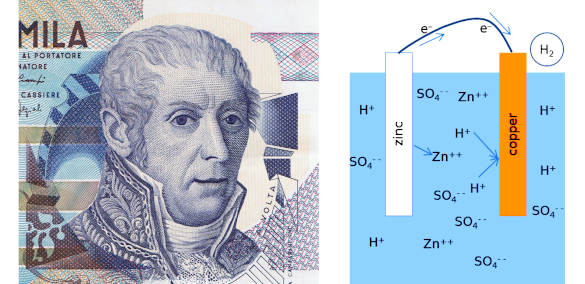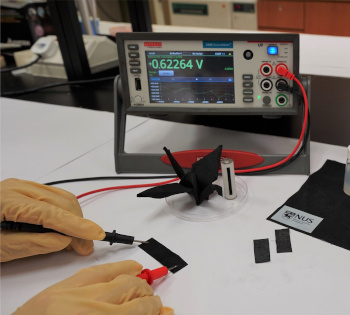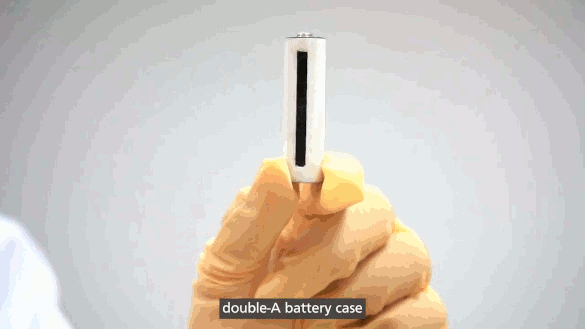Hygroscopic Energy
March 6, 2023
Battery power has enhanced our
quality of life by
energizing small
devices, such as
smartphones and
tablet computers, as well as our much larger
electric cars. Many of these devices incorporate
rechargeable batteries, but there are still many devices, such as
television remote controls and
children's toys, that utilize non-rechargeable
primary batteries enabled by
irreversible electrochemical reactions.
A simple example of a primary battery is the
copper/zinc cell. The first battery, the 1799
voltaic pile of
Alessandro Volta (1745-1827), was a
series arrangement of
copper/
zinc cells using
salt water brine as the
electrolyte. A modern example, as shown in the figure, uses a
sulfuric acid electrolyte. Its irreversibility is easily seen by the loss of
hydrogen gas from the system.

Alessandro Volta (1745-1827) and a copper/zinc battery. The zinc anode (the material that supplies the electrons to an external circuit) and copper cathode (the material accepting electrons from an external circuit) are immersed in a sulfuric acid electrolyte. Doubly-charged zinc ions are dissolved in the electrolyte and hydrogen ions combine with electrons at the copper cathode to produce hydrogen gas. (Left image, portion of a Wikimedia Commons image of a 10,000 Italian Lira bank note. Right image, a Wikimedia Commons image by Easchiff. Click for larger image.)
Although batteries operate by
chemical reactions, the real
stars of the process are the ions and electrons. You can create a battery without a chemical reaction if you have a
reservoir of ions and can move them from one
electrode to another. This approach was used in a device that produces
electric power from
humid air.[1-3] The
research team members were from the
National University of Singapore, the
Agency for Science, Technology and Research (Singapore), and
Bruker Corporation (Singapore). The team was led by
Tan Swee Ching, an
assistant professor in the
Department of Materials Science and Engineering of the National University of Singapore.[2]
Presently, such devices known as
moisture-driven energy generators (MEG) will produce
energy only until they are
saturated with
water.[1-2] The
Singapore research team developed a
novel asymmetric hygroscopic structure that
harvests energy from
moisture in the air and stores the generated electricity as a battery would.[1] The device consists of a 0.3
millimeter thick layer of a
non-woven fabric of
wood pulp and
polyester coated with
carbon nanoparticles.[1-3] One side of a strip of fabric, the
wet region, is coated with a hygroscopic ionic hydrogel that absorbs about 4.5 times its
weight in water.[3]
Sea salt, mixed into the hydrogel, is used to harvest moisture from the air.[2] Says Tan,
"Sea salt was chosen as the water-absorbing compound due to its non-toxic properties and its potential to provide a sustainable option for desalination plants to dispose of the generated sea salt and brine."[2]
The other side of the fabric strip, the
dry region, does not contain the hygroscopic ionic hydrogel layer.[2] Absorbed water from the air creates a wet-dry asymmetry across the strip and this produces an
in-plane electric field that exists even after saturated water absorption.[1] The absorbed water creates an
electrical double layer, as in
supercapacitor, over the carbon
surface.[1] The supercapacitor structure allows for energy storage.[1] A single strip produces a
potential of nearly a
volt, and the strips can be connected in series for larger
voltage, as in that of conventional batteries.[3]

Voltage output of a moisture-driven energy generator strip. The digital voltmeter reads about 0.62 volts.
The carbon coating causes the black color of the strip. An origami folded strip, still capable of voltage generation, can be seen in front of the voltmeter.
(Portion of a National University of Singapore image, also here.)
After being saturated by water, a 1.5
centimeter x 2
centimeter strip was shown to provide a voltage of about 0.7 volts for more than 150
hours.[2] After 30
days, the hydrogel was still saturated with water, the voltage output was the same, and a peak
power density of 70
microwatts per
cm3 was realized.[1] The device can store electricity, just as a supercapacitor, when voltage is applied.[1-2] This energy harvester has high
flexibility and it can withstand stress from
twisting,
rolling, and
bending.[2] As a demonstration of this, an
origami crane was created with the fabric, and the overall electrical performance of the device was not affected.[2]
One such strip will output 0.7 volts, but a series connection of strips will give higher voltage, such as the 1.5-1.9 volts of a typical battery[3] As a demonstration of this, the researchers integrated strips into a
3D printed case that was the size of a
standard AA battery.[2] The voltage of that battery was as high as 1.96 volts, and it powered the
analog alarm clock shown below.[2-3]

Analog alarm clock powered by a battery created from moisture-driven energy generating strips. (Still images from a YouTube video by the National University of Singapore College of Design and Engineering.)[3]
The
raw materials for this device are easily obtained, and the final
fabricated cost is about ten
cents per
square meter.[2] As Tan says, "Our device shows excellent
scalability at a low fabrication cost. Compared to other MEG structures and devices, our
invention is simpler and easier for scaling-up integrations and connections. We believe it holds vast promise for
commercialization."[2] The researchers have filed a
patent for this
technology.[2]
References:
- Yaoxin Zhang, Shuai Guo, Zhi Gen Yu, Hao Qu, Wanxin Sun, Jiachen Yang, Lakshmi Suresh, Xueping Zhang, J. Justin Koh, and Swee Ching Tan, "An Asymmetric Hygroscopic Structure for Moisture-Driven Hygro-Ionic Electricity Generation and Storage," Advanced Materials, vol. 34, no. 21 (May 26, 2022), article no. 2201228, DOI: https://doi.org/10.1002/adma.202201228.
- NUS researchers invent self-charging, ultra-thin device that generates electricity from air moisture, National University of Singapore Press Release, August 17, 2022.
- A battery powered by moisture from the air, YouTube Video by the National University of Singapore College of Design and Engineering.
Linked Keywords: Battery (electricity); electric power; quality of life; energy; energizing; consumer electronics; electronic device; smartphone; tablet computer; electric car; rechargeable battery; television remote control; child; children; toy; primary battery; irreversible process; electrochemistry; electrochemical; chemical reaction; lemon battery; copper/zinc cell; voltaic pile; Alessandro Volta (1745-1827); series circuit; copper; zinc; electrochemical cell; salt water brine; electrolyte; sulfuric acid; hydrogen; gas; anode; material; electron; electronic circuit; cathode; electric charge; doubly-charged; ion; dissolution (chemistry); dissolved; Wikimedia Commons; Italian Lira bank note; Easchiff; celebrity; star; reservoir; electrode; electric power; humidity; humid; atmosphere of Earth; air; research; National University of Singapore; Agency for Science, Technology and Research (Singapore); Bruker Corporation (Singapore); Tan Swee Ching; assistant professor; Department of Materials Science and Engineering of the National University of Singapore; saturation (chemistry); saturated; water; Singapore; novelty; novel; asymmetry; asymmetric; hygroscopy; hygroscopic; energy harvesting; harvest energy; moisture; millimeter; weaving; non-woven; fabric; pulp (paper); wood pulp; polyester; coating; coated; carbon; nanoparticle; wet; weight; sea salt; toxicity; non-toxic; desalination plant; brine; arid; dry; plane (geometry}; in-plane; electric field; double layer (surface science); electrical double layer; supercapacitor; surface; electric potential; volt; voltage; digital voltmeter; centimeter; day; power density; microwatt; cubic centimetre; cm3; flexibility (engineering); torque; twisting; rolling (metalworking); bending; origami; crane (bird); 3D printing; 3D printed; AA battery; analog alarm clock; raw material; manufacturing; fabricate; cost; penny (United States coin); cent; square meter; scalability; invention; commercialization; patent; technology.